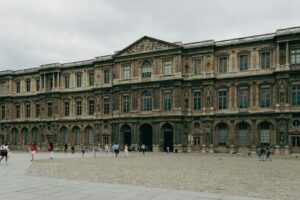In the annals of history, the period from 1450 to 1750 is often overlooked when considering French technological innovations. Yet, it’s a time brimming with remarkable advancements that shaped not only France but the world at large. This article will delve into the heart of these transformative years, shedding light on the inventions that propelled France into a new era of technological prowess.
French Technological Innovations 1450 To 1750
Embarking on a journey through the French Renaissance, one unearths pivotal technological innovations that propelled France into a new era. This period, characterized by a significant growth of arts and sciences, gave rise to inventions that transformed the world in unimaginable ways.
The Printing Press: Challenging the Manuscript Culture
As a tangible representation of ingenuity, the advent of the Printing Press during the French Renaissance marked a stark shift from the erstwhile manuscript culture. Johann Gutenberg’s innovation in 1450 signaled a remarkable leap forward in communication and information dissemination. The invention of the press equipped with movable components made way for mass production of texts, previously a tedious pursuit confined to monasteries. Books, once a luxury few could afford, became accessible to the masses, stimulating literacy rates. Illustrating the change, figures show a sharp increase in the number of books within France – from a few thousand in 1500 to more than 20 million by 1600.
The Advent of Metal movable Type

In conjunction with the rise of the Printing Press, the advent of the metal movable type played an indispensable role in development. Gutenberg’s use of metal type pieces made from an alloy of lead, tin and antimony proved game-changing. With this innovation, individual characters could be cast, arranged, and reused with ease, significantly reducing the time and effort invested in printing. Contribution to this technical revolution reflects, among other evidence, in the stark uptake in Almanachs production — from 30,000 copies annually to over 300,000 — a clear display of the effectiveness of Gutenberg’s ingenious innovation.
Early Modern Period (1520-1660) and Innovative Upheaval
A wave of disruptive technological changes swept France during the Early Modern Period. They ingeniously reshaped the domains of navigation, exploration, and computation.
Maritime Innovations: Navigation, Exploration and Trade

As France stepped into the Early Modern Period, maritime innovation took a significant leap. Among the most transformative advancements, navigational tools like the astrolabe and the sextant proved invaluable, easing course plotting and improving distance estimation. These devices offered sailors a more secure grasp of their location on the high seas, driving better exploration and safer trade routes – a true game-changer for France’s maritime endeavors.
Developments in shipbuilding also made a striking impact. Galleons, sturdier and more spacious, became the mainstay of French fleets. Armed with multiple decks of guns, these ships were instrumental in solidifying France’s naval supremacy. An epitome of French shipbuilding was the ‘Le Grande Hermine’, a vessel that promptly beat the Atlantic’s fierce currents during Jacques Cartier’s voyage to Canada.
Emergence of Mechanical Computing Devices
The Early Modern Period in France also saw the advent of computing marvels. Among the most noteworthy were the early mechanical calculators or Pascalines, christened after their inventor, Blaise Pascal. In 1642, at a tender age of just 19, Pascal introduced this arithmetic machine – an accomplishment that marked the dawn of mechanical computation.
Pascaline, capable of performing basic calculations, was a breakthrough in computational technology. It employed a set of wheels and gears to execute addition and subtraction. For more complex calculations like multiplication and division, subsequent iterations used a repeated addition or subtraction method, respectively. This innovative approach to problem-solving yielded more efficient computations, providing a clear demonstration of the burgeoning intelligence of French inventors during this era.
The Rise of Classical French Technology (1660-1750)
This segment delves deep into the era marking the rise of classical French technology, spanning from the year 1660 to 1750, focusing primarily on prominent breakthroughs in sciences and groundbreaking advances in military and construction engineering.
Breakthroughs in Sciences: Physics and Biology

During this period, French scientists and inventors led crucial developments in the spheres of both physics and biology. Significant names in the world of physics, like Edme Mariotte, emerge. Mariotte pioneered fluid mechanics, notably acknowledging the direct relationship between pressure and volume of gases, termed Mariotte’s law.
Parallelly, in biology, significant strides were taken. French biologist, Jan Swammerdam, perfected the technique of dissection and presented his meticulous study of the anatomy and life cycles of insects. His work laid the groundwork for future scientific inquiry into entomology, contributing immensely to the field of biology.
Advances in Military and Construction Engineering
France’s significant advancements were not limited to the field of natural sciences. The period from 1660 to 1750 witnessed a significant boost in French military and construction engineering. Sébastien Le Prestre de Vauban, a military engineer under the reign of Louis XIV, played a vital role in revolutionizing fortress designs across France’s borders. His methods, known as Vauban fortifications, still influence military architecture today.
Moreover, in the realm of construction engineering, French architects and engineers made significant contributions that transformed the way buildings were designed and built. In particular, François Mansart, an influential French architect, masterfully implemented technical innovations to produce complex architectural designs. He is credited with introducing the Mansard roof, a distinctive roof style, equipping buildings with extra living space, and giving rise to modern attic space. These innovations underscore the technological dominance France held during this era.